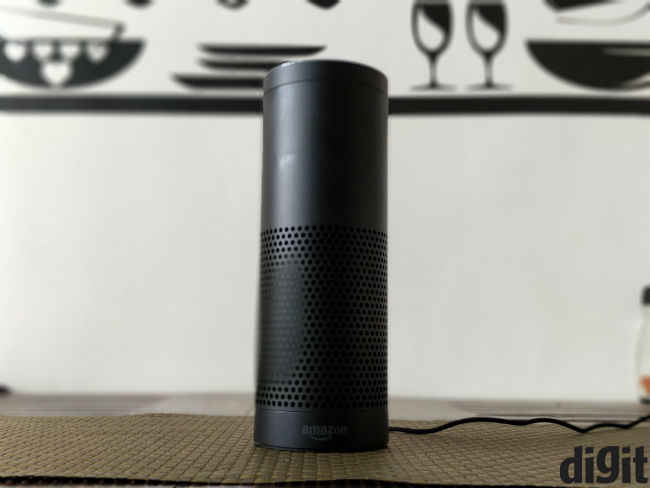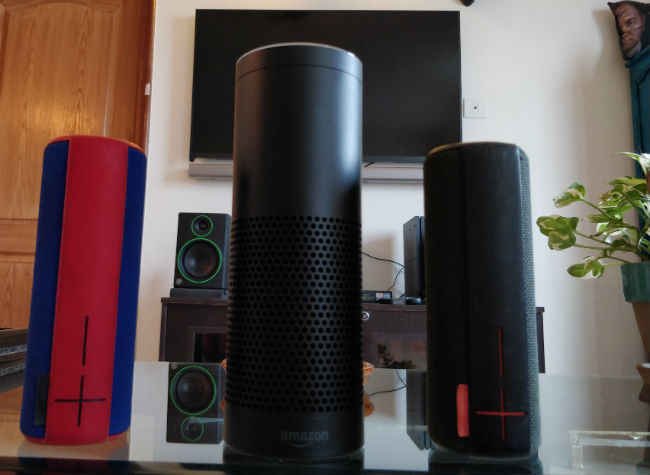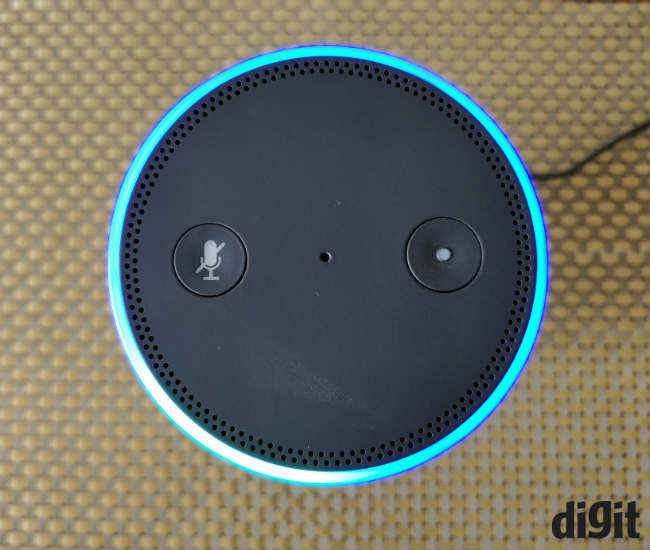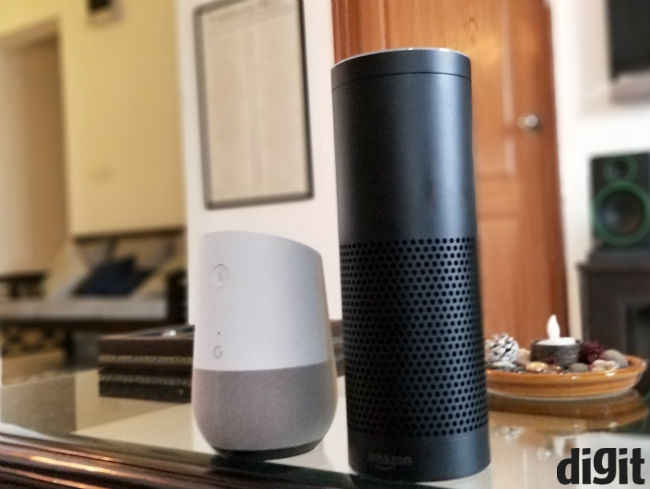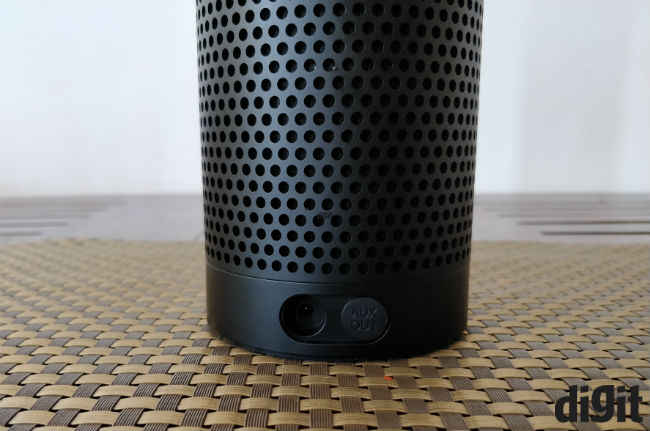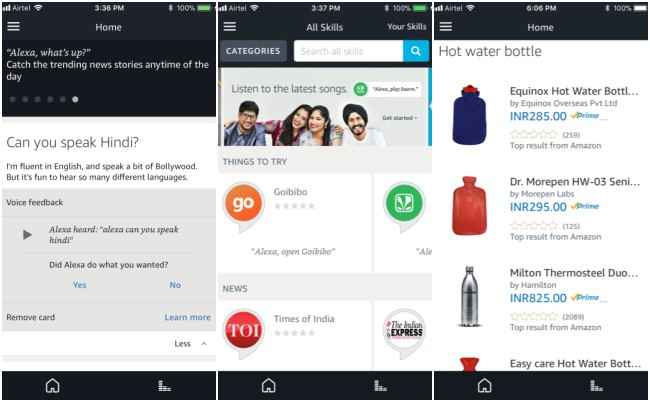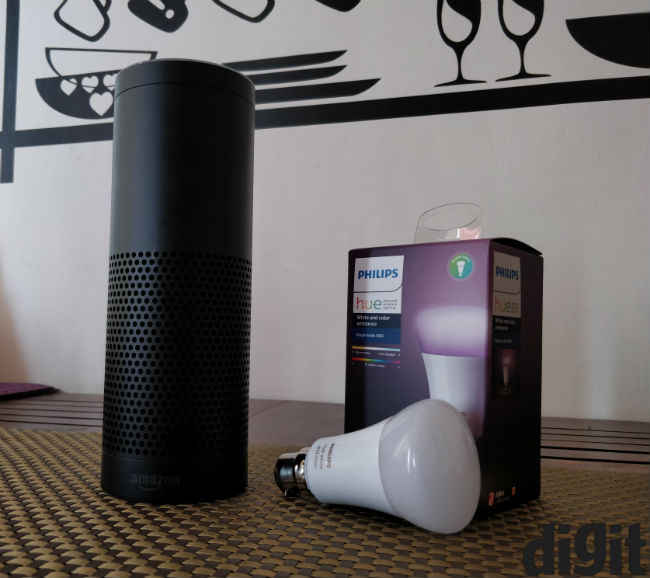Here’s what it’s like to use the Amazon Echo Plus in India
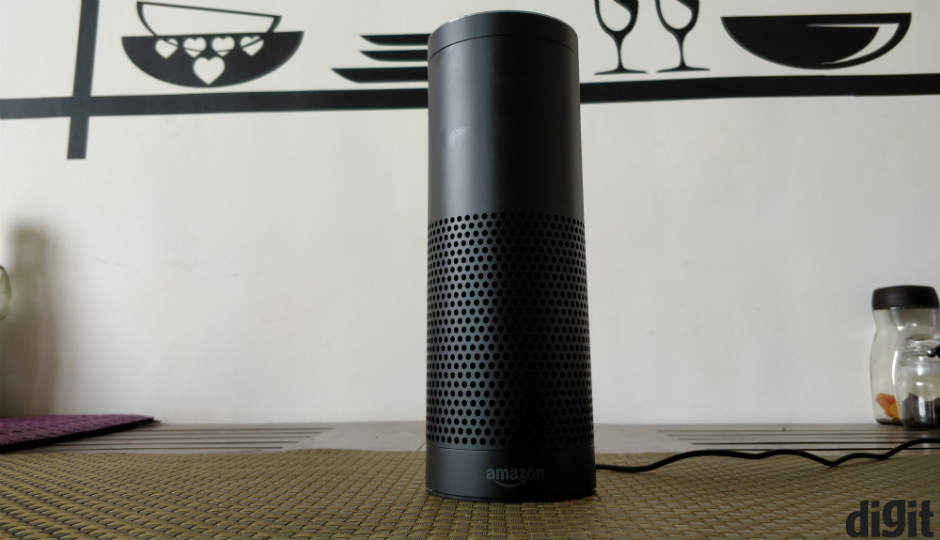
India’s first official smart home speaker with an AI assistant - the Amazon Echo - is finally shipping out to consumers. We spent 48 hours with the Echo Plus to figure out all of Alexa’s local skills. Here are our initial thoughts on the relevance of the speaker in an Indian household.
When Amazon’s hardware development arm, Lab126, filed early patents for the Echo speakers in 2010, it was destined to become an augmented reality device. One patent application suggested a device that would allow people to walk around their homes interacting with AR screens, another described a device for understanding spoken words, songs, claps and whistles, while tracking a user’s movements. Four years later, in 2014, Alexa and the Echo were born.
While Amazon may have scaled down its AR ambitions to create the Echo, it was a decision made for the greater good. The AR device would have definitely been costlier to produce and even pricier to purchase. It’s still difficult to imagine the average Indian walking into their home and starting a conversation with a machine. Interaction with screens floating in the air would seem too futuristic, even to the technologically evolved west, let alone India.
Nevertheless, three years after launching the Echo speakers and paving the way for human-computer speech interactions, Amazon is finally dipping its toes in the Indian market.
In India, we have an option of purchasing the Rs 3,149 Echo Dot, the Rs 6,999 Echo or the Rs 10,499 Echo Plus. I spent 48 hours with the most expensive of the lot – the Amazon Echo Plus. Here's what transpired.
Build and Design
From the get go, the Amazon Echo Plus looks like a tall cylinder – 9.3-inches in height and 3.3-inches in diameter. With a weight of almost 1Kg, the Echo Plus is not light as a feather, but it’s not unwieldy either. The Echo Plus sits comfortably in a corner on my dining table and seamlessly merges with jars of condiments on it if you were to whisk a glance. When I placed it on a designated table for my Mackie speakers, consoles, etc, it looked like just another gadget, and couldn’t steal the show from the White coloured Xbox One S.
I have a Black coloured Echo Plus, which is the only colour available in India. In the US, Amazon also offers the device in metallic Silver and White finishes. Perhaps, the speaker looks more striking in Silver or White given its sheer size, but even in Black, it stands out in a crowd of similar-looking Bluetooth speakers owing to its large size. However, I prefer the UE Boom's thin and light composition compared to that of the Echo Plus. Then again, the UE Boom is as dumb as they come and won’t let me talk to it.
UE Boom Black and Red against the Echo Plus
At the top of the Echo Plus is a mute button and an action button encircled by the light ring which emits a cool Blue when Alexa is triggered. Just beside the blue light ring is the grille for the Echo’s array of microphones, seven to be exact, that help the speaker hear its users thanks to beam-forming technology and noise cancellation. The microphones allow the Echo Plus to hear users from all different directions. Amazon calls it Far-field voice recognition.
A volume ring rests just beneath the microphone array and the two buttons. Although Alexa can be commanded to reduce the volume, sometimes you just want to reach out and give the volume ring a swirl when you’re close to the speaker. When turned, the light ring produces a white colour, visually communicating that the volume is being turned up or down. A classy touch, that Amazon could have incorporated on the smaller Echo Dot as well.
I own a Google Home speaker (1st Gen) as well (It’s not officially available in India) and it features a touch interface at the top to turn volume up/down. For me, both mechanisms are at par with each other and add to the appeal of their respective products.
The bottom half of the cylindrical Echo Plus features a large grille, behind which rest the Zigbee radio – a wireless standard for smart home devices, a 2.5-inch woofer and a 0.8-inch tweeter.
The power port and 3.5mm audio out port rest inside a notch at the bottom. Only the Aux out port has a cover to avoid splashes. The device is not waterproof or even water resistant, something we wish it was given its various use cases. But, you can purchase waterproof covers for the speaker separately. Further, users should note that the Echo Plus is not a wireless speaker and does not house a battery. It needs to stay connected to a power outlet all throughout the day.
Overall, the Echo Plus feels like a sturdy device, one that would not easily disintegrate. Teardown experts ifixit gave the original Echo a repairability score of 7, given its layered, modular internals. The Echo Plus is not much different than the original Echo in terms of how the device is structured, it’s just bigger and packs in more abilities.
Alexa, can you understand me?
With over 1500 skills, Alexa is a learned AI. It’s abilities are varied, but in the time I spent interacting with the Echo Plus, it seemed less intuitive than the Google Assistant. Alexa sounds robotic, while the Google Assistant sounds more humanistic.
Alexa tends to take fewer pauses between words and rarely places punctuations correctly, except for when it asks you a question. That said, Alexa has just taken its first steps in the nightmare that India is with its countless languages and dialects. Compiling and learning from such a large and varied dataset of spoken languages will take Alexa some time to master.
The AI assistant definitely has an Indian accent, but it cannot understand Hindi as of now. Multiple reports recently pointed out that Alexa can understang a few Hindi words and some Hinglish. Reports mentioned words like ‘Zeera’, ‘Haldi’, ‘Dhaniya’ and ‘Atta’. When spoken to in Hinglish, the AI helper struggles to understand and commands have to be repeated multiple times before it responds correctly. Alexa understood me when I asked it to order ‘Haldi’ from Amazon, but kept mistaking ‘Zeera’ for ‘Zero’. When I tried placing an order for ‘Atta’, it gave me an option to purchase Maggi Atta Noodles.
Language is something Alexa will surely pick up as it continues to learn from Indian speakers. Meanwhile, speaking to Alexa in English is pretty seamless and it recognises my unmistakably Indian accent very well.
Voice Commands and Skills
The USP of the Echo Plus is its ability to respond to voice commands and perform subsequent tasks. Alexa on the Echo Plus in India can be commanded to buy products from Amazon; Play music from Amazon Music, Saavn or TuneIn radio; control connected home devices from Philips Hue, Syska, TP-Link and others; order a cab from Ola or Uber; read out news from Times of India, Indian Express, HT and other local and international publications; order food and book tables on Zomato; check flight schedules from Jet Airways; dictate Tarla Dalal recipes; play games; tell jokes; beatbox; sing; tell stories and the list goes on.
Shopping
When I tried purchasing some puppy supplies on Amazon, Alexa understood what I asked for and responded with products from my frequently ordered brands. You can speak to the Echo Plus and tell it order anything available on Amazon, however, even if it recognises what you want, it does not read out more that two purchase options for the product. Instead, after listing out two products, it simply tells the user to view more options on the Alexa app. Payments are deducted from a user's Amazon Pay Balance by default. However, CoD becomes a default option only when a customer does not have sufficient Amazon Pay Balance.
What I really missed was the visual confirmation of the product I was purchasing. Somehow, when you see a product and its packaging, it is easier to identify with and instills trust in the purchase. I guess that’s why Amazon came up with the Echo Show.
Cabs
Ordering an Uber with voice commands was also easy, but I had to pre-feed my Echo Plus’ location and complete address in the Alexa app before doing so. The Echo Plus cannot detect location and I guess that makes sense since it is supposed to be a fixed home device. Those using it as a home hub would probably not carry it around.
Music
For skills like Saavn, you will need to create an account on the music streaming platform or link your existing account through the app. You can then issue commands like “Play Arijit Singh Songs on Saavn”, “Next Song”, “Play top bollywood songs”, and more. The Saavn app houses tracks from artists like Ed Sheeran, Katy Perry and others international artists, apart from popular Indian music. But, Saavn is not the highlight of the Echo’s music streaming abilities.
The Amazon Prime Music service is available to all Echo users. Commands like “Alexa, Play Music from Prime Music” generates responses like “Here’s a playlist you may like”. At first, Prime Music was not working on my Echo Plus device and was generating an error response. Problem was that my Prime Music account was linked to Amazon.com instead of Amazon.in. A call to Amazon’s customer care quickly resolved the issue and I started using Prime Music without a hitch.
At first impressions, Amazon Prime Music is as good as music on demand gets in India. It could search and play every song query I threw at it. The service houses a large library of English, Hindi and even Punjabi music, old and new. A search for “top tracks” got me listening to a playlist with the latest Bollywood music, so obviously, the service has been localised for India. We even played classics from Abba, Eagles, The Beatles and Prime Music lapped up all our requests with ease.
Amazon Prime Music in India is impressive to say the least and I simply love the way it just works. What’s also great about playing music through the Alexa app is that it can search for tracks across platforms. If a track is not available on Prime Music, Alexa automatically searches for it on Saavn and plays it out.
The Echo Plus (or any other Echo speaker) can be connected to a Bluetooth speaker of your preference. The Echo Plus also features an Aux out for wired connectivity to other speakers.
In a gist, Amazon Prime Music’s awesome library of songs combined with the ability to stream them on any speaker, makes the Echo Plus a dream come true for music lovers.
News
Alexa has set commands for when you need news to be read out to you. “What’s my Flash Briefing”, or “What’s the news today?” work perfectly. Most of the international news publications I subscribe to play out pre-recorded news segments, complete with professional voice overs, background music and proper sound packaging.
On the other hand, most Indian publishers on the platform, for instance ToI or Indian Express, simply make Alexa read out the top headlines of the day and it's excruciating to hear tham because of Alexa’s unnatural enunciation and lack of proper pauses.
Commands like “What’s my flash briefing from Indian Express” or any other particular publisher’s skill, are supposed to work, but didn’t in my experience. Whenever I would ask for news from a particular publication by name, Alexa would start reading out the news in the order in which the skills were added to the app by me. This can be frustrating and we hope Amazon improves the experience going forward.
You may be wondering if you can issue commands to the Echo Plus from anywhere in your house? Well, that depends on how big your house is. The Echo Plus could hear my voice commands from the next room which was 25 feet away, but I literally had to shout at it to be heard. This justifies the existence of the Echo Dot; the smallest hockey-puck shaped Echo speaker can be purchased separately and placed in various rooms for the convenience of issuing voice commands from the room of your choice.
Routines
A great feature of the Echo Plus and the Alexa app is that they allow you to set a routine. Setting a routine on the Alexa app lets users customise commands to automatically make the Echo device perform a particular function. Think of IFTTT. Routines function similarly.
For instance, you can program Alexa to respond to a “Good Morning” command with the news and weather report for the day. Similarly, the “Good Night” command can be programmed to switch off connected lights.
Alexa’s routines can also be set to correspond to a particular time of the day and you have an option to repeat routines on a daily or weekly basis.
Alexa App
The Amazon Alexa app is available for both Android and iOS. The app is essential to setup and use any Echo device, including the Echo Plus. The setup process is easy and all you need to do is follow instructions on the Alexa app to start pairing and using your Echo device.
The app is a tad slow, but does not hang or randomly crash. The home screen on the Alexa app features a ‘Things to Try’ section right on top. Here, users are prompted to try various Alexa commands. Below this section, the home screen displays information cards about your recent activity and interactions with Alexa. Here, you will also find all the previous questions you asked Alexa with an option to share feedback with Amazon. It’s like checking your browser history. Users have an option of deleting their activity information cards and usage history from the app.
All the skills we talked about in the ‘Voice Commands and Skills’ section can be viewed and added through the ‘Skills’ tab on the Alexa app.
Home Automation
Now this is where things get a little messy for India. The home automation industry is still at a nascent stage of development and adoption in the country. One rarely finds connected lights, let alone IoT coffee makers in an average Indian home.
As we told you before, the Echo Plus houses a Zigbee radio which essentially makes it a home hub for most of your connected devices. It can talk directly to your gadgets as per voice commands issued by you. You must have heard about Philips Hue light bulbs and LED strips which can be controlled via an app. The Echo Plus will let you switch these IoT lights off and on through simple voice commands. However, it is important to note that the Echo Plus does not come bundled with any Philips Hue light bulbs and they have to be purchased separately.
The cheapest Philips Hue bulb would set you back Rs 3,400 for a single bulb, going all the way up to Rs 30,000 for a starter kit with three bulbs. Yes, home automation is expensive in India.
Echo Plus – The speaker
If you ask me, I would be happier pairing the Echo Plus with my own Bluetooth speakers (The Mackies or even the UE Boom) rather than using the device’s in-built speaker system.
If I had to describe it in one word, I would say that the Echo Plus is ‘Loud’. It features digital sound processing by Dolby and 360 degree omnidirectional audio. It does not distort at high volumes, but can get a bit uncomfortable due to its underwhelming bass.
At first impressions, I would say that The Echo Plus is not at power with a 10K-15K Bluetooth speaker, but it’s not bad either. It just about does the job when interacting with Alexa, but you would be better off connecting to other speaker/s for your music listening pleasure.
So is the Echo Plus well suited for the Indian user? As a techie, I am really impressed with the Echo since it’s a device I have been looking forward to for a while now. It lets me shop, listen to ‘desi’ and international and music, play games when I am bored, stay updated with the latest locally relevant news, control connected appliances and more. It even entertain my house help when I’m not at home.
If all this is something you are looking for in a smart speaker, the Echo Plus can be yours at Rs 10,499. If you are someone only interested in Amazon Music and Alexa’s skills, without a smart home hub for connected appliances, you will be better off with the cheaper Echo or the Echo Dot. Meanwhile, we will spend some more time with the Echo Plus as it learns, grows and evolves in India.

